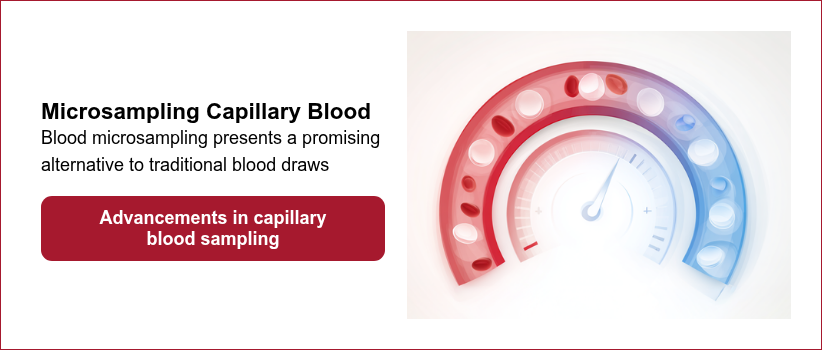Share this
fingerstick devices: safety risks, infection concerns & best practices for safe use
by Neoteryx Microsampling on Apr 17, 2018 8:02:00 AM
Finger-stick or capillary blood sampling has long been a convenient method for collecting small blood volumes in clinical and home settings. These devices, often referred to as lancing devices or fingerstick devices, make testing for glucose, cholesterol, and other analytes quick and minimally invasive.
However, as with all blood collection methods, safety concerns exist. Improper use or failure to follow infection-control procedures can expose patients and healthcare workers to bloodborne pathogens, lead to inaccurate results, or cause local tissue injury.
This article examines key safety considerations surrounding finger-stick blood sampling and outlines evidence-based practices to minimize risk.
Understanding Finger-stick and Lancing Devices
Switching to capillary blood collection devices can help us avoid some of the dangers associated with wet blood sample shipping and storage, such as compromised stability of blood samples. However, improper capillary blood collection methods can create hazards as well. To ensure the sample collection process is safe, it is important to understand the potential risks.
Fingerstick or lancing devices pierce the skin’s surface to draw capillary blood, typically from the fingertip. Devices range from single-use disposable lancets to multi-use systems with replaceable tips.
While convenient, any reuse of a fingerstick device across multiple patients poses significant risk of cross-contamination. Even with cleaning, microscopic traces of blood can remain on reusable components, potentially transmitting pathogens such as hepatitis B virus (HBV) or hepatitis C virus (HCV) between individuals.
"In finger-sticks, the blood flowing freely from the site of the puncture exposes both the healthcare worker taking the sample and the environment to blood-borne infectious agents that the patient may have," noted Sharon M. Geaghan, M.D., in an interview with Clinical Lab Pathologist.
Taking extra precautions to wash the hands before and after sample collection can help mitigate this risk. For the person being sampled, disinfecting the lanced fingertip immediately after sampling and covering it with a bandage is recommended.
For the person assisting with finger-stick sampling, wearing gloves and/or washing or disinfecting the hands before and after is advised.
Best Practices for Safe Finger-stick Sampling
Before Sampling
- Wash hands thoroughly with soap and warm water.
- Inspect the lancing device for any visible damage or contamination.
- Use a new, single-use lancet for each test.
During Sampling
- Choose a lateral fingertip site to minimize discomfort.
- Use proper depth settings to avoid excessive tissue injury.
- Avoid squeezing the finger excessively, which may dilute the specimen.
After Sampling
- Dispose of the lancet in a puncture-proof sharps container.
- Wipe down any surfaces with approved disinfectant.
- Record the sample time and any irregularities.
Key Reminder: Follow manufacturer instructions and local policy for all disinfection and disposal procedures.
Traditional Sampling vs. Finger-Stick Sampling
Traditionally, venous blood is drawn via a needle placed in the arm by a phlebotomist who collects vials of wet blood that are cold shipped to hospital labs and clinical labs for testing. This approach requires people to visit a medical or lab facility for assisted "blood work" sampling with a healthcare professional – an appointment that many of us dread.
While many hospitals and labs are set up for conventional sampling and testing of "wet blood," there is a movement to shift more systems over to dried blood sampling for efficiency, convenience and potential cost savings.
The shift to remote finger-stick microsampling has benefits, including:
- Reduces hospital and lab visits for study volunteers or patients;
- Reduces staffing needs for trained phlebotomists;
- Eliminates expensive cold shipping and storage; and
- Streamlines workflows in both clinical and research labs.
Capillary finger-stick blood sampling has become more commonly applied in research, decentralized clinical trials, population studies, disease monitoring, toxicology, anti-doping and other industries. This is partly in response to innovations in devices used for point of care testing and remote microsampling.
Capillary blood sampled from a fingertip can have distinct advantages over traditional blood draws from a vein in the arm, including the ability to collect samples at home or in other remote locations – often without assistance from a health professional.
Blood samples collected from a fingertip deliver a dried blood sample, which can be mailed to the lab sealed in a specimen bag that fits inside a standard shipping envelope for sending via regular post. These microsamples will dry during transit and remain stable until analysis in the lab.
Reap the Benefits of Finger-Stick Sampling
In addition to being more patient-centric than venipuncture, capillary finger-stick blood sampling can save time and money in research, pharmaceutical clinical trials and analysis in clinical and hospital labs.
Microsampling is considered relatively easy to implement without disruption to a laboratory workflow if the lab is set up for processing and analyzing conventional dried blood spot (DBS) filter cards.
As compared to traditional wet blood and plasma collection using venipuncture, capillary blood microsampling with a quick finger-stick is easier. Microsampling solutions like the Mitra® device with VAMS® technology are designed so that nearly anyone can perform the procedure with minimal training.
Understanding the safety concerns puts us in a better position to take advantage of this powerful innovation and appreciate its usefulness in:
- Clinical settings
- Remote therapeutic drug monitoring (TDM)
- Preclinical animal research
- Molecular studies,
- Toxicology
And other scientific research areas, with more applications in development.
For Those Working in the Field/ Low Resource regions

Using remote microsampling devices that are based on volumetric absorptive microsampling is much easier than using dried blood spot (DBS) cards and filter paper.
One reason is that a sampling device based on VAMS technology has an absorptive tip that will collect the exact sample volume needed for accurate analysis. There is no second-guessing or struggling to land a blood drop within a tiny circle on a DBS filter card, and no need to air dry the samples before shipping.
Just touch the VAMS tips of the Mitra device to the drop of blood on your finger until filled. Close up the device immediately after sampling. Place the sampled device inside the specimen bag, and place that in a standard shipping envelope for mailing to a central lab.
The samples dry during transit, thanks to a packet of drying desiccant inside the specimen bag. No cold storage or cold shipping is necessary.

Image credits: Trajan, Neoteryx
Share this
- Microsampling (206)
- Research, Remote Research (119)
- Venipuncture Alternative (105)
- Clinical Trials, Clinical Research (83)
- Mitra® Device (73)
- Therapeutic Drug Monitoring, TDM (51)
- Dried Blood Spot, DBS (39)
- Biomonitoring, Health, Wellness (30)
- Infectious Disease, Vaccines, COVID-19 (24)
- Blood Microsampling, Serology (23)
- Omics, Multi-Omics (21)
- Decentralized Clinical Trial (DCT) (20)
- Specimen Collection (18)
- Toxicology, Doping, Drug/Alcohol Monitoring, PEth (17)
- Skin Microsampling, Microbiopsy (14)
- hemaPEN® Device (13)
- Preclinical Research, Animal Studies (12)
- Pharmaceuticals, Drug Development (9)
- Harpera Device (7)
- Industry News, Microsampling News (5)
- Antibodies, MAbs (3)
- Company Press Release, Product Press Release (3)
- Environmental Toxins, Exposures (1)
- July 2025 (1)
- May 2025 (1)
- April 2025 (2)
- December 2024 (2)
- November 2024 (1)
- October 2024 (3)
- September 2024 (1)
- June 2024 (1)
- May 2024 (1)
- April 2024 (4)
- March 2024 (1)
- February 2024 (2)
- January 2024 (4)
- December 2023 (3)
- November 2023 (3)
- October 2023 (3)
- September 2023 (3)
- July 2023 (3)
- June 2023 (2)
- April 2023 (2)
- March 2023 (2)
- February 2023 (2)
- January 2023 (3)
- December 2022 (2)
- November 2022 (3)
- October 2022 (4)
- September 2022 (3)
- August 2022 (5)
- July 2022 (2)
- June 2022 (2)
- May 2022 (4)
- April 2022 (3)
- March 2022 (3)
- February 2022 (4)
- January 2022 (5)
- December 2021 (3)
- November 2021 (5)
- October 2021 (3)
- September 2021 (3)
- August 2021 (4)
- July 2021 (4)
- June 2021 (4)
- May 2021 (4)
- April 2021 (3)
- March 2021 (5)
- February 2021 (4)
- January 2021 (4)
- December 2020 (3)
- November 2020 (5)
- October 2020 (4)
- September 2020 (3)
- August 2020 (3)
- July 2020 (6)
- June 2020 (4)
- May 2020 (4)
- April 2020 (3)
- March 2020 (6)
- February 2020 (3)
- January 2020 (4)
- December 2019 (5)
- November 2019 (4)
- October 2019 (2)
- September 2019 (4)
- August 2019 (4)
- July 2019 (3)
- June 2019 (7)
- May 2019 (6)
- April 2019 (5)
- March 2019 (6)
- February 2019 (5)
- January 2019 (8)
- December 2018 (3)
- November 2018 (4)
- October 2018 (7)
- September 2018 (6)
- August 2018 (5)
- July 2018 (8)
- June 2018 (6)
- May 2018 (5)
- April 2018 (6)
- March 2018 (4)
- February 2018 (6)
- January 2018 (4)
- December 2017 (2)
- November 2017 (3)
- October 2017 (2)
- September 2017 (4)
- August 2017 (2)
- July 2017 (4)
- June 2017 (5)
- May 2017 (6)
- April 2017 (6)
- March 2017 (5)
- February 2017 (4)
- January 2017 (1)
- July 2016 (3)
- May 2016 (1)
- April 2016 (2)


/Mitra_Media%20Library%20Images%20(March-April%202023)/mitra-with-remote-collection-kit-opened.jpg?width=3956&height=2640&name=mitra-with-remote-collection-kit-opened.jpg)

Comments (2)